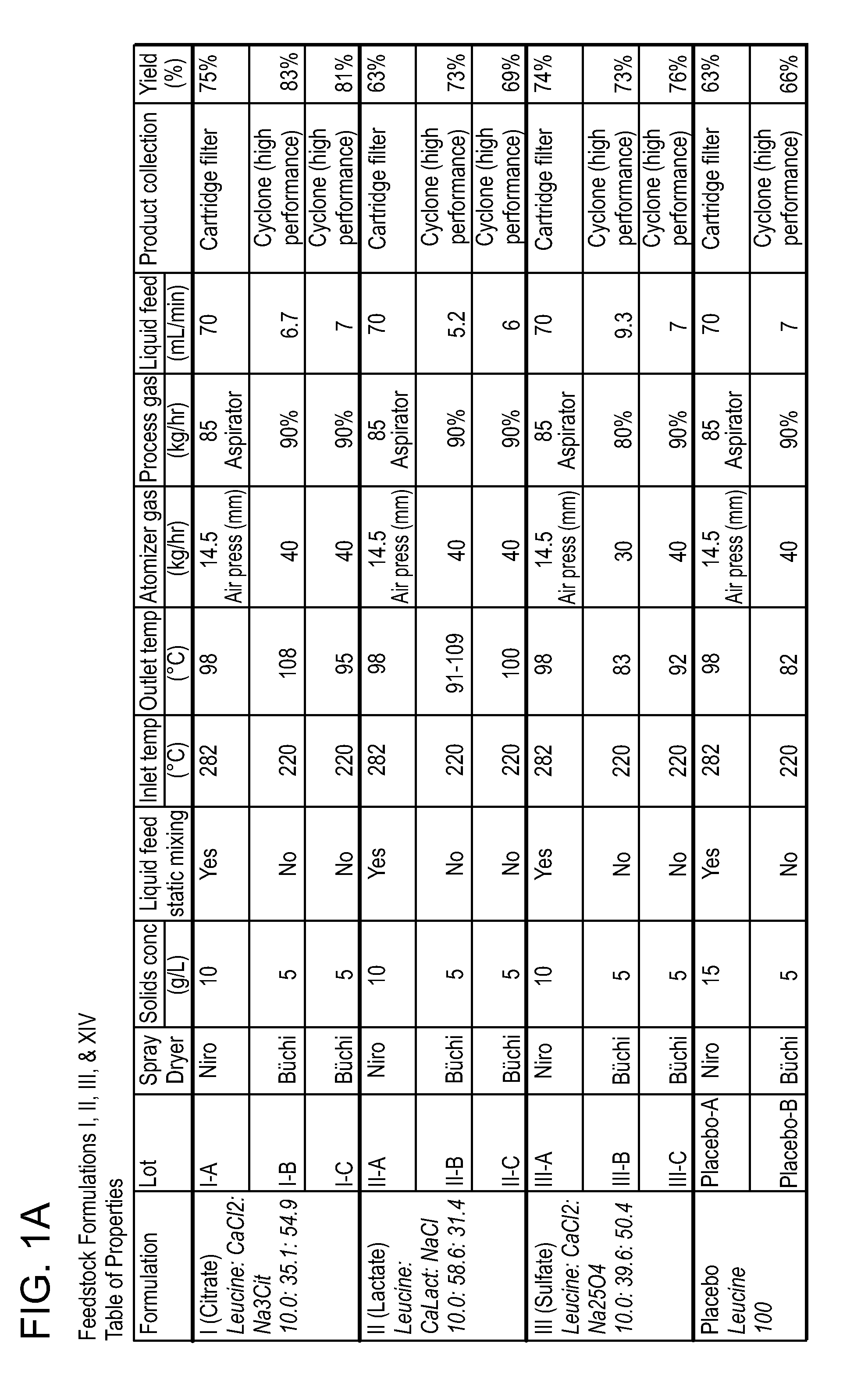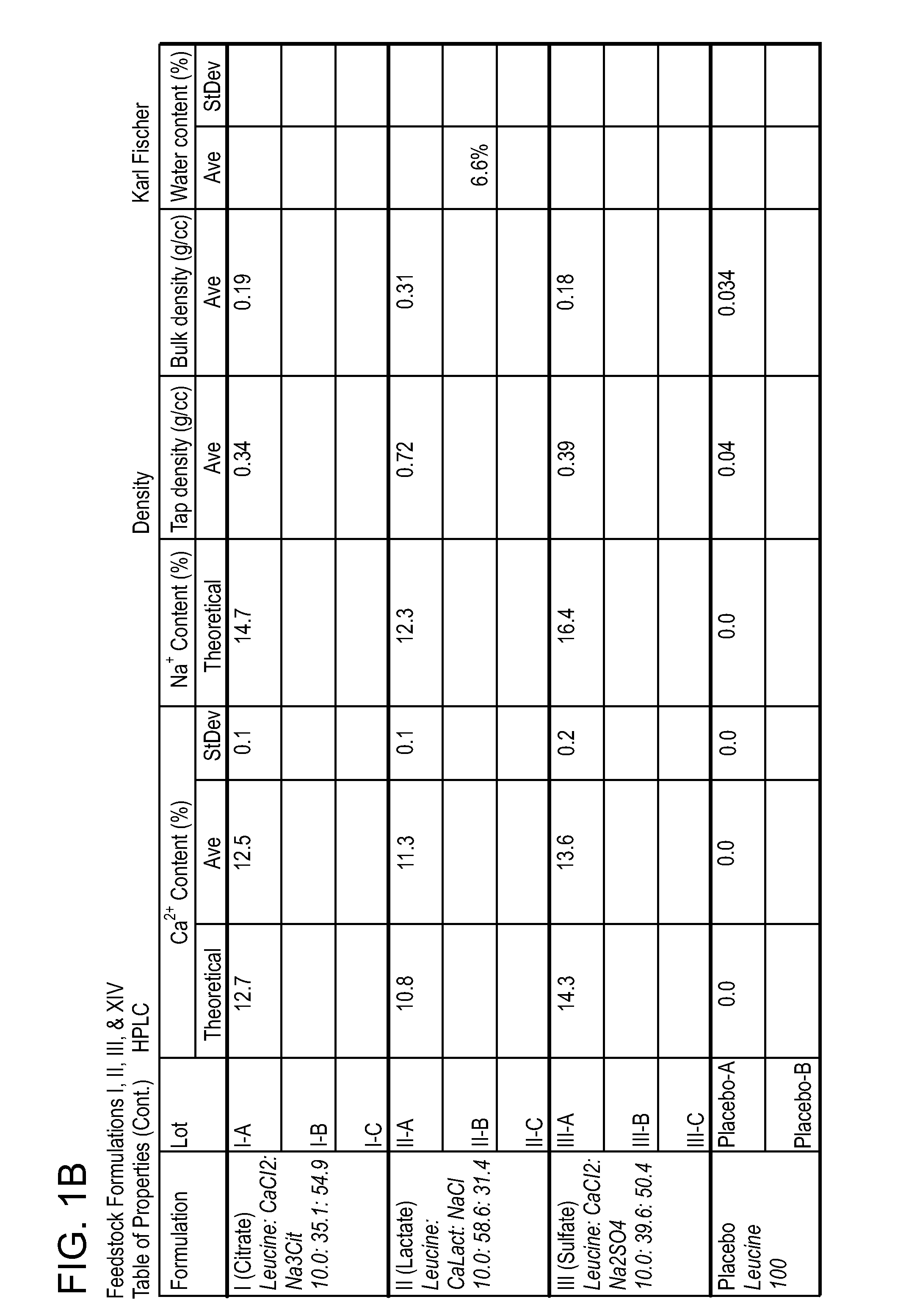Dry powder formulations and methods for treating pulmonary diseases
a technology of pulmonary diseases and formulations, applied in the direction of biocide, antibacterial agents, drug compositions, etc., can solve the problems of significant recirculation of bulk drug solutions, lack of uniform size of liquid aerosol droplets, and low pressure at the exit region, so as to reduce the risk of pulmonary disease, prevent and/or reduce the contagion of infectious diseases, and treat the effect of preventing and/or reducing the contagion
- Summary
- Abstract
- Description
- Claims
- Application Information
AI Technical Summary
Benefits of technology
Problems solved by technology
Method used
Image
Examples
example 1
[0252]This example describes the preparation of dry powders using feedstock of Formulation I: 10.0 weight percent leucine, 35.1 weight percent calcium chloride and 54.9 weight percent sodium citrate.
[0253]An aqueous phase was prepared for a batch process by dissolving leucine in ultrapure water, then sodium citrate dihydrate, and finally calcium chloride dihydrate. The solution or suspension was kept agitated throughout the process until the materials were completely dissolved in the water at room temperature. For a static mixing process, the sodium salt and calcium salt were kept in separate solutions. The ultrapure water was divided in half and half of the total required leucine was dissolved in each volume of water. The sodium citrate dihydrate was dissolved in one aqueous phase and the calcium chloride dihydrate dissolved in the second aqueous phase. The solutions or suspensions were kept agitated throughout the process until the materials were completely dissolved in the water ...
example 2
[0260]This example describes the preparation of dry powders using feedstock of Formulation II: 10.0 weight percent leucine, 58.6 weight percent calcium lactate and 31.4 weight percent sodium chloride.
[0261]An aqueous phase was prepared for a batch process by dissolving leucine in ultrapure water, then sodium chloride, and finally calcium lactate pentahydrate. The solution was kept agitated throughout the process until the materials were completely dissolved in the water at room temperature. For the calcium lactate formulation, four batches (A, B, C and D) of feedstock were prepared and spray dried. Details on the liquid feedstock preparations for each of the four batches are shown in Table 7, where the total solids concentration is reported as the total of the dissolved anhydrous material weights. Batch A and D particles were prepared using batch A and D feedstock, respectively on a Niro spray dryer. The process conditions used for spray drying Batch A (II-A) were similar to the con...
example 3
[0265]This example describes the preparation of dry powders using feedstock of Formulation III: 10 weight percent leucine, 39.6 weight percent calcium chloride and 50.4 weight percent sodium sulfate.
[0266]An aqueous phase was prepared for a batch process by dissolving leucine in ultrapure water, then sodium sulfate, and finally calcium chloride dihydrate. The solution or suspension was kept agitated throughout the process until the materials were completely dissolved in the water at room temperature. For a static mixing process, the sodium salt and calcium salt were kept in separate solutions. The ultrapure water was divided in half and half of the total required leucine was dissolved in each volume of water. The sodium sulfate was dissolved in one aqueous phase and the calcium chloride dihydrate dissolved in the second aqueous phase. The solutions or suspensions were kept agitated throughout the process until the materials were completely dissolved in the water at room temperature....
PUM
| Property | Measurement | Unit |
|---|---|---|
| tap density | aaaaa | aaaaa |
| volume median geometric diameter | aaaaa | aaaaa |
| particle size | aaaaa | aaaaa |
Abstract
Description
Claims
Application Information
 Login to View More
Login to View More - R&D
- Intellectual Property
- Life Sciences
- Materials
- Tech Scout
- Unparalleled Data Quality
- Higher Quality Content
- 60% Fewer Hallucinations
Browse by: Latest US Patents, China's latest patents, Technical Efficacy Thesaurus, Application Domain, Technology Topic, Popular Technical Reports.
© 2025 PatSnap. All rights reserved.Legal|Privacy policy|Modern Slavery Act Transparency Statement|Sitemap|About US| Contact US: help@patsnap.com



